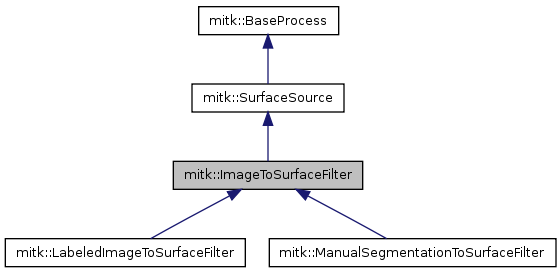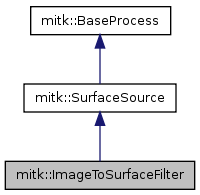Converts pixel data to surface data by using a threshold The mitkImageToSurfaceFilter is used to create a new surface out of an mitk image. The filter uses a threshold to define the surface. It is based on the vtkMarchingCube algorithm. By default a vtkPolyData surface based on an input threshold for the input image will be created. Optional it is possible to reduce the number of triangles/polygones [SetDecimate(mitk::ImageToSurfaceFilter::DecimatePro) and SetTargetReduction (float _arg)] or smooth the surface-data [SetSmooth(true), SetSmoothIteration(int smoothIteration) and SetSmoothRelaxation(float smoothRelaxation)]. More...
#include <mitkImageToSurfaceFilter.h>


Public Types | |
| enum | DecimationType { NoDecimation, DecimatePro } |
| typedef ImageToSurfaceFilter | Self |
| typedef SurfaceSource | Superclass |
| typedef itk::SmartPointer< Self > | Pointer |
| typedef itk::SmartPointer < const Self > | ConstPointer |
Public Member Functions | |
| virtual const char * | GetClassName () const |
| virtual void | GenerateData () |
| virtual void | GenerateOutputInformation () |
| const mitk::Image * | GetInput (void) |
| virtual void | SetInput (const mitk::Image *image) |
| void | SetSmoothIteration (int smoothIteration) |
| void | SetSmoothRelaxation (float smoothRelaxation) |
| virtual void | SetThreshold (ScalarType _arg) |
| virtual ScalarType | GetThreshold () const |
| virtual void | SetSmooth (bool _arg) |
| virtual void | SmoothOn () |
| virtual void | SmoothOff () |
| virtual bool | GetSmooth () const |
| virtual DecimationType | GetDecimate () const |
| virtual void | SetDecimate (DecimationType _arg) |
| virtual void | SetTargetReduction (float _arg) |
| virtual float | GetTargetReduction () const |
| template<class T1 , class T2 , class T3 > | |
| void | mitkVtkLinearTransformPoint (T1 matrix[4][4], T2 in[3], T3 out[3]) |
Static Public Member Functions | |
| static Pointer | New () |
Protected Member Functions | |
| ImageToSurfaceFilter () | |
| virtual | ~ImageToSurfaceFilter () |
| void | CreateSurface (int time, vtkImageData *vtkimage, mitk::Surface *surface, const ScalarType threshold) |
Protected Attributes | |
| bool | m_Smooth |
| DecimationType | m_Decimate |
| ScalarType | m_Threshold |
| float | m_TargetReduction |
| int | m_SmoothIteration |
| float | m_SmoothRelaxation |
Converts pixel data to surface data by using a threshold The mitkImageToSurfaceFilter is used to create a new surface out of an mitk image. The filter uses a threshold to define the surface. It is based on the vtkMarchingCube algorithm. By default a vtkPolyData surface based on an input threshold for the input image will be created. Optional it is possible to reduce the number of triangles/polygones [SetDecimate(mitk::ImageToSurfaceFilter::DecimatePro) and SetTargetReduction (float _arg)] or smooth the surface-data [SetSmooth(true), SetSmoothIteration(int smoothIteration) and SetSmoothRelaxation(float smoothRelaxation)].
The resulting vtk-surface has the same size as the input image. The surface can be generally smoothed by vtkDecimatePro reduce complexity of triangles and vtkSmoothPolyDataFilter to relax the mesh. Both are enabled by default and connected in the common way of pipelining in ITK. It's also possible to create time sliced surfaces.
Definition at line 53 of file mitkImageToSurfaceFilter.h.
| typedef itk::SmartPointer<const Self> mitk::ImageToSurfaceFilter::ConstPointer |
Reimplemented in mitk::LabeledImageToSurfaceFilter, and mitk::ManualSegmentationToSurfaceFilter.
Definition at line 65 of file mitkImageToSurfaceFilter.h.
| typedef itk::SmartPointer<Self> mitk::ImageToSurfaceFilter::Pointer |
Reimplemented in mitk::LabeledImageToSurfaceFilter, and mitk::ManualSegmentationToSurfaceFilter.
Definition at line 65 of file mitkImageToSurfaceFilter.h.
Reimplemented in mitk::LabeledImageToSurfaceFilter, and mitk::ManualSegmentationToSurfaceFilter.
Definition at line 65 of file mitkImageToSurfaceFilter.h.
Reimplemented in mitk::LabeledImageToSurfaceFilter, and mitk::ManualSegmentationToSurfaceFilter.
Definition at line 65 of file mitkImageToSurfaceFilter.h.
Definition at line 63 of file mitkImageToSurfaceFilter.h.
| mitk::ImageToSurfaceFilter::ImageToSurfaceFilter | ( | ) | [protected] |
Definition at line 34 of file mitkImageToSurfaceFilter.cpp.
: m_Smooth(false), m_Decimate( NoDecimation), m_Threshold(1.0), m_TargetReduction(0.95f), m_SmoothIteration(50), m_SmoothRelaxation(0.1) { }
| mitk::ImageToSurfaceFilter::~ImageToSurfaceFilter | ( | ) | [protected, virtual] |
| void mitk::ImageToSurfaceFilter::CreateSurface | ( | int | time, |
| vtkImageData * | vtkimage, | ||
| mitk::Surface * | surface, | ||
| const ScalarType | threshold | ||
| ) | [protected] |
With the given threshold vtkMarchingCube creates the surface. By default nothing a vtkPolyData surface based on a threshold of the input image will be created. Optional it is possible to reduce the number of triangles/polygones [SetDecimate(mitk::ImageToSurfaceFilter::DecimatePro) and SetTargetReduction (float _arg)] or smooth the data [SetSmooth(true), SetSmoothIteration(int smoothIteration) and SetSmoothRelaxation(float smoothRelaxation)].
| time | selected slice or "0" for single |
| *vtkimage | input image |
| *surface | output |
| threshold | can be different from SetThreshold() |
Definition at line 48 of file mitkImageToSurfaceFilter.cpp.
References mitk::ProgressBar::GetInstance(), matrix(), mitk::ProgressBar::Progress(), and mitk::Surface::SetVtkPolyData().
{
vtkImageChangeInformation *indexCoordinatesImageFilter = vtkImageChangeInformation::New();
indexCoordinatesImageFilter->SetInput(vtkimage);
indexCoordinatesImageFilter->SetOutputOrigin(0.0,0.0,0.0);
//MarchingCube -->create Surface
vtkMarchingCubes *skinExtractor = vtkMarchingCubes::New();
skinExtractor->ComputeScalarsOff();
skinExtractor->SetInput(indexCoordinatesImageFilter->GetOutput());//RC++
indexCoordinatesImageFilter->Delete();
skinExtractor->SetValue(0, threshold);
vtkPolyData *polydata;
polydata = skinExtractor->GetOutput();
polydata->Register(NULL);//RC++
skinExtractor->Delete();
if (m_Smooth)
{
vtkSmoothPolyDataFilter *smoother = vtkSmoothPolyDataFilter::New();
//read poly1 (poly1 can be the original polygon, or the decimated polygon)
smoother->SetInput(polydata);//RC++
smoother->SetNumberOfIterations( m_SmoothIteration );
smoother->SetRelaxationFactor( m_SmoothRelaxation );
smoother->SetFeatureAngle( 60 );
smoother->FeatureEdgeSmoothingOff();
smoother->BoundarySmoothingOff();
smoother->SetConvergence( 0 );
polydata->Delete();//RC--
polydata = smoother->GetOutput();
polydata->Register(NULL);//RC++
smoother->Delete();
}
ProgressBar::GetInstance()->Progress();
//#if (VTK_MAJOR_VERSION >= 5)
// if (m_Decimate == Decimate )
// {
// MITK_ERROR << "vtkDecimate not available for VTK 5.0 and above.";
// MITK_ERROR << " Using vtkDecimatePro instead." << std::endl;
// m_Decimate = DecimatePro;
// }
//#endif
//decimate = to reduce number of polygons
if(m_Decimate==DecimatePro)
{
vtkDecimatePro *decimate = vtkDecimatePro::New();
decimate->SplittingOff();
decimate->SetErrorIsAbsolute(5);
decimate->SetFeatureAngle(30);
decimate->PreserveTopologyOn();
decimate->BoundaryVertexDeletionOff();
decimate->SetDegree(10); //std-value is 25!
decimate->SetInput(polydata);//RC++
decimate->SetTargetReduction(m_TargetReduction);
decimate->SetMaximumError(0.002);
polydata->Delete();//RC--
polydata = decimate->GetOutput();
polydata->Register(NULL);//RC++
decimate->Delete();
}
#if (VTK_MAJOR_VERSION < 5)
else if (m_Decimate==Decimate)
{
vtkDecimate *decimate = vtkDecimate::New();
decimate->SetInput( polydata );
decimate->PreserveTopologyOn();
decimate->BoundaryVertexDeletionOff();
decimate->SetTargetReduction( m_TargetReduction );
polydata->Delete();//RC--
polydata = decimate->GetOutput();
polydata->Register(NULL);//RC++
decimate->Delete();
}
#endif
polydata->Update();
ProgressBar::GetInstance()->Progress();
polydata->SetSource(NULL);
if(polydata->GetNumberOfPoints() > 0)
{
mitk::Vector3D spacing = GetInput()->GetGeometry(time)->GetSpacing();
vtkPoints * points = polydata->GetPoints();
vtkMatrix4x4 *vtkmatrix = vtkMatrix4x4::New();
GetInput()->GetGeometry(time)->GetVtkTransform()->GetMatrix(vtkmatrix);
double (*matrix)[4] = vtkmatrix->Element;
unsigned int i,j;
for(i=0;i<3;++i)
for(j=0;j<3;++j)
matrix[i][j]/=spacing[j];
unsigned int n = points->GetNumberOfPoints();
vtkFloatingPointType point[3];
for (i = 0; i < n; i++)
{
points->GetPoint(i, point);
mitkVtkLinearTransformPoint(matrix,point,point);
points->SetPoint(i, point);
}
vtkmatrix->Delete();
}
ProgressBar::GetInstance()->Progress();
surface->SetVtkPolyData(polydata, time);
polydata->UnRegister(NULL);
}
| void mitk::ImageToSurfaceFilter::GenerateData | ( | ) | [virtual] |
For each image time slice a surface will be created. This method is called by Update().
Reimplemented in mitk::LabeledImageToSurfaceFilter, and mitk::ManualSegmentationToSurfaceFilter.
Definition at line 166 of file mitkImageToSurfaceFilter.cpp.
References mitk::ProgressBar::AddStepsToDo(), mitk::ProgressBar::GetInstance(), mitk::SlicedData::GetRequestedRegion(), mitk::Image::GetVtkImageData(), mitk::ProgressBar::Progress(), and QuadProgPP::t().
{
mitk::Surface *surface = this->GetOutput();
mitk::Image * image = (mitk::Image*)GetInput();
mitk::Image::RegionType outputRegion = image->GetRequestedRegion();
int tstart=outputRegion.GetIndex(3);
int tmax=tstart+outputRegion.GetSize(3); //GetSize()==1 - will aber 0 haben, wenn nicht zeitaufgeloest
if ((tmax-tstart) > 0)
{
ProgressBar::GetInstance()->AddStepsToDo( 4 * (tmax - tstart) );
}
int t;
for( t=tstart; t < tmax; ++t)
{
vtkImageData *vtkimagedata = image->GetVtkImageData(t);
CreateSurface(t,vtkimagedata,surface,m_Threshold);
ProgressBar::GetInstance()->Progress();
}
}
| void mitk::ImageToSurfaceFilter::GenerateOutputInformation | ( | void | ) | [virtual] |
Initializes the output information ( i.e. the geometry information ) of the output of the filter
Reimplemented in mitk::LabeledImageToSurfaceFilter.
Definition at line 219 of file mitkImageToSurfaceFilter.cpp.
{
mitk::Image::ConstPointer inputImage =(mitk::Image*) this->GetInput();
//mitk::Image *inputImage = (mitk::Image*)this->GetImage();
mitk::Surface::Pointer output = this->GetOutput();
itkDebugMacro(<<"GenerateOutputInformation()");
if(inputImage.IsNull()) return;
//Set Data
}
| virtual const char* mitk::ImageToSurfaceFilter::GetClassName | ( | ) | const [virtual] |
Reimplemented in mitk::LabeledImageToSurfaceFilter, and mitk::ManualSegmentationToSurfaceFilter.
| virtual DecimationType mitk::ImageToSurfaceFilter::GetDecimate | ( | ) | const [virtual] |
Get the state of decimation mode to reduce triangle in the surface represantation. Modes can only be NoDecimation or DecimatePro (till vtk 4.x also Decimate)
| const mitk::Image * mitk::ImageToSurfaceFilter::GetInput | ( | void | ) |
Returns a const reference to the input image (e.g. the original input image that ist used to create the surface)
Definition at line 207 of file mitkImageToSurfaceFilter.cpp.
{
if (this->GetNumberOfInputs() < 1)
{
return 0;
}
return static_cast<const mitk::Image * >
( this->ProcessObject::GetInput(0) );
}
| virtual bool mitk::ImageToSurfaceFilter::GetSmooth | ( | ) | const [virtual] |
| virtual float mitk::ImageToSurfaceFilter::GetTargetReduction | ( | ) | const [virtual] |
Returns the reduction factor for the VtkDecimatePro Decimation Filter as a float value
| virtual ScalarType mitk::ImageToSurfaceFilter::GetThreshold | ( | ) | const [virtual] |
Get Threshold from vtkMarchingCube. Threshold can be manipulated by inherited classes.
| void mitk::ImageToSurfaceFilter::mitkVtkLinearTransformPoint | ( | T1 | matrix[4][4], |
| T2 | in[3], | ||
| T3 | out[3] | ||
| ) | [inline] |
Transforms a point by a 4x4 matrix
Definition at line 172 of file mitkImageToSurfaceFilter.h.
| static Pointer mitk::ImageToSurfaceFilter::New | ( | ) | [static] |
Reimplemented from mitk::SurfaceSource.
Reimplemented in mitk::LabeledImageToSurfaceFilter, and mitk::ManualSegmentationToSurfaceFilter.
| virtual void mitk::ImageToSurfaceFilter::SetDecimate | ( | DecimationType | _arg ) | [virtual] |
Enable the decimation filter to reduce the number of triangles in the mesh and produce a good approximation to the original image. The filter has support for vtk-5 and earlier versions. More detailed information check the vtkDecimatePro and vtkDecimate.
| void mitk::ImageToSurfaceFilter::SetInput | ( | const mitk::Image * | image ) | [virtual] |
Set the source image to create a surface for this filter class. As input every mitk 3D or 3D+t image can be used.
Definition at line 200 of file mitkImageToSurfaceFilter.cpp.
{
// Process object is not const-correct so the const_cast is required here
this->ProcessObject::SetNthInput(0, const_cast< mitk::Image * >( image ) );
}
| virtual void mitk::ImageToSurfaceFilter::SetSmooth | ( | bool | _arg ) | [virtual] |
Enables vtkSmoothPolyDataFilter. With Laplacian smoothing this filter will relax the surface. You can control the Filter by manipulating the number of iterations and the relaxing factor.
| void mitk::ImageToSurfaceFilter::SetSmoothIteration | ( | int | smoothIteration ) |
Set the number of iterations that is used to smooth the surface. Used is the vtkSmoothPolydataFilter that uses the laplacian filter. The higher the number of iterations that stronger the smooth-result
| smoothIteration | As smoothIteration default in that case 50 was choosen. The VTK documentation recommends small relaxation factors and large numbers of iterations. |
Definition at line 190 of file mitkImageToSurfaceFilter.cpp.
{
m_SmoothIteration = smoothIteration;
}
| void mitk::ImageToSurfaceFilter::SetSmoothRelaxation | ( | float | smoothRelaxation ) |
Set number of relaxation. Specify the relaxation factor for Laplacian smoothing. The VTK documentation recommends small relaxation factors and large numbers of iterations.
| smoothRelaxation | As smoothRelaxation default in that case 0.1 was choosen. The VTK documentation recommends small relaxation factors and large numbers of iterations. |
Definition at line 195 of file mitkImageToSurfaceFilter.cpp.
{
m_SmoothRelaxation = smoothRelaxation;
}
| virtual void mitk::ImageToSurfaceFilter::SetTargetReduction | ( | float | _arg ) | [virtual] |
| virtual void mitk::ImageToSurfaceFilter::SetThreshold | ( | ScalarType | _arg ) | [virtual] |
Threshold that is used to create the surface. All pixel in the input image that are higher than that value will be considered in the surface. The threshold referees to vtkMarchingCube. Default value is 1. See also SetThreshold (ScalarType _arg)
| virtual void mitk::ImageToSurfaceFilter::SmoothOff | ( | ) | [virtual] |
| virtual void mitk::ImageToSurfaceFilter::SmoothOn | ( | ) | [virtual] |
DecimationType mitk::ImageToSurfaceFilter::m_Decimate [protected] |
Decimation mode, default mode is "NoDecimation". See also SetDecimate (DecimationType _arg)
Definition at line 213 of file mitkImageToSurfaceFilter.h.
bool mitk::ImageToSurfaceFilter::m_Smooth [protected] |
Flag whether the created surface shall be smoothed or not (default is "false"). SetSmooth (bool _arg)
Definition at line 208 of file mitkImageToSurfaceFilter.h.
int mitk::ImageToSurfaceFilter::m_SmoothIteration [protected] |
The Iteration value for the Smooth Filter of the created surface. See also SetSmoothIteration (int smoothIteration)
Definition at line 229 of file mitkImageToSurfaceFilter.h.
float mitk::ImageToSurfaceFilter::m_SmoothRelaxation [protected] |
The Relaxation value for the Smooth Filter of the created surface. See also SetSmoothRelaxation (float smoothRelaxation)
Definition at line 234 of file mitkImageToSurfaceFilter.h.
float mitk::ImageToSurfaceFilter::m_TargetReduction [protected] |
The Reduction factor of the Decimation Filter for the created surface. See also SetTargetReduction (float _arg)
Definition at line 224 of file mitkImageToSurfaceFilter.h.
ScalarType mitk::ImageToSurfaceFilter::m_Threshold [protected] |
Threshold that is used to create the surface. All pixel in the input image that are higher than that value will be considered in the surface. Default value is 1. See also SetThreshold (ScalarType _arg)
Definition at line 219 of file mitkImageToSurfaceFilter.h.
 1.7.2
1.7.2